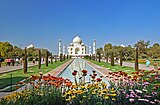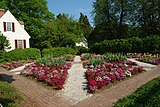
The early history of gardening is largely entangled with the history of agriculture, with gardens that were mainly ornamental generally the preserve of the elite until quite recent times. Smaller gardens generally had being a kitchen garden as their first priority, as is still often the case.

A parterre is a part of a formal garden constructed on a level substrate, consisting of symmetrical patterns, made up by plant beds, plats, low hedges or coloured gravels, which are separated and connected by paths. Typically it was the part of the garden nearest the house, perhaps after a terrace. The view of a parterre from inside the house, especially from the upper floors, was a major consideration in its design. The word "parterre" was and is used both for the whole part of the garden containing parterres and for each individual section between the "alleys".
Garden design is the art and process of designing and creating plans for layout and planting of gardens and landscapes. Garden design may be done by the garden owner themselves, or by professionals of varying levels of experience and expertise. Most professional garden designers have some training in horticulture and the principles of design. Some are also landscape architects, a more formal level of training that usually requires an advanced degree and often a state license. Amateur gardeners may also attain a high level of experience from extensive hours working in their own gardens, through casual study, serious study in Master gardener programs, or by joining gardening clubs.
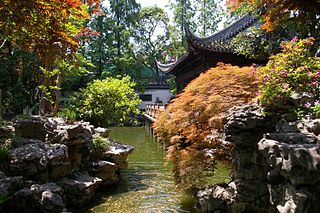
The Chinese garden is a landscape garden style which has evolved over three thousand years. It includes both the vast gardens of the Chinese emperors and members of the imperial family, built for pleasure and to impress, and the more intimate gardens created by scholars, poets, former government officials, soldiers and merchants, made for reflection and escape from the outside world. They create an idealized miniature landscape, which is meant to express the harmony that should exist between man and nature.

The English landscape garden, also called English landscape park or simply the English garden, is a style of "landscape" garden which emerged in England in the early 18th century, and spread across Europe, replacing the more formal, symmetrical French formal garden which had emerged in the 17th century as the principal gardening style of Europe. The English garden presented an idealized view of nature. Created and pioneered by William Kent and others, the "informal" garden style originated as a revolt against the architectural garden and drew inspiration from landscape paintings by Salvator Rosa, Claude Lorrain, and Nicolas Poussin.
This is an alphabetical index of articles related to gardening.

In the French formal garden, a bosquet is a formal plantation of trees in a wide variety of forms, some open at the bottom and others not. At a minimum a bosquet can be five trees of identical species planted as a quincunx, or set in strict regularity as to rank and file, so that the trunks line up as one passes along either face. In large gardens they were dense artificial woodland, often covering large areas, with tall hedges on the outside and other trees inside the hedges. Symbolic of order in a humanized and tamed gardens of the French Renaissance and Baroque French formal gardens, the bosquet is an analogue of the orderly orchard, an amenity that has been intimately associated with pleasure gardening from the earliest Persian gardens of the Achaemenid Empire.

The Château de Méréville is a chateau in Méréville in the valley of the Juine, France. It is the rival of the Désert de Retz as two of the most extensive Landscape Gardens provided with follies and picturesque features — parcs à fabriques — made in the late eighteenth century. Both are early examples of the romantic French Landscape Garden — jardin a l'anglaise — an interpretation of the English garden style that was replacing the Garden à la française. the Château de Méréville and garden park survive, partially dismantled.

André Le Nôtre, originally rendered as André Le Nostre, was a French landscape architect and the principal gardener of King Louis XIV of France. He was the landscape architect who designed the gardens of the Palace of Versailles; his work represents the height of the French formal garden style, or jardin à la française.
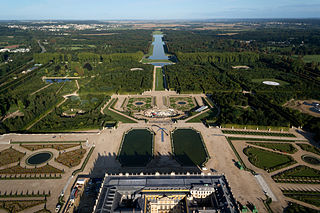
The French formal garden, also called the jardin à la française, is a style of "landscape" garden based on symmetry and the principle of imposing order on nature. Its epitome is generally considered to be the Gardens of Versailles designed during the 17th century by the landscape architect André Le Nôtre for Louis XIV and widely copied by other European courts.

Gardens of the French Renaissance were initially inspired by the Italian Renaissance garden, which evolved later into the grander and more formal jardin à la française during the reign of Louis XIV, by the middle of the 17th century.

The French landscape garden is a style of garden inspired by idealized romantic landscapes and the paintings of Hubert Robert, Claude Lorrain and Nicolas Poussin, European ideas about Chinese gardens, and the philosophy of Jean-Jacques Rousseau. The style originated in England as the English landscape garden in the early 18th century, and spread to France where, in the second half of the 18th century and early 19th century, it gradually replaced the rigidly clipped and geometrical French formal garden.
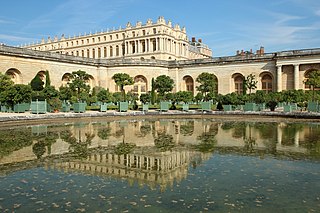
The Versailles Orangerie was built by Jules Hardouin-Mansart between 1684 and 1686, before work on the Château de Versailles had even begun. The Orangerie, which replaced Louis Le Vau's earlier design from 1663, is an example of many such prestigious extensions of grand gardens in Europe designed both to shelter tender plants and impress visitors. With the addition of the Orangerie, the gardens, no longer reserved solely for use by Louis XIV, had the added use of a theatrical setting that could be used to entertain guests at court.

The Potager du roi, near the Palace of Versailles, produced fresh vegetables and fruits for the table of the court of Louis XIV. It was created between 1678 and 1683 by Jean-Baptiste de La Quintinie, the director of the royal fruit and vegetable gardens. Today it is run by the École nationale supérieure du paysage, the grande école for landscape architects. It is officially recognized as a Remarkable Garden of France.

Italian garden typically refers to a style of gardens, wherever located, reflecting a number of large Italian Renaissance gardens which have survived in something like their original form. In the history of gardening, during the Renaissance, Italy had the most advanced and admired gardens in Europe, which greatly influenced other countries, especially the French formal garden and Dutch gardens and, mostly through these, gardens in Britain.

The Baroque garden was a style of garden based upon symmetry and the principle of imposing order on nature. The style originated in the late-16th century in Italy, in the gardens of the Vatican and the Villa Borghese gardens in Rome and in the gardens of the Villa d'Este in Tivoli, and then spread to France, where it became known as the jardin à la française or French formal garden. The grandest example is found in the Gardens of Versailles designed during the 17th century by the landscape architect André Le Nôtre for Louis XIV. In the 18th century, in imitation of Versailles, very ornate Baroque gardens were built in other parts of Europe, including Germany, Austria, Spain, and in Saint-Petersburg, Russia. In the mid-18th century the style was replaced by the less geometric and more natural English landscape garden.

Paris today has more than 421 municipal parks and gardens, covering more than three thousand hectares and containing more than 250,000 trees. Two of Paris's oldest and most famous gardens are the Tuileries Garden, created in 1564 for the Tuileries Palace, and redone by André Le Nôtre in 1664; and the Luxembourg Garden, belonging to a château built for Marie de' Medici in 1612, which today houses the French Senate. The Jardin des Plantes was the first botanical garden in Paris, created in 1626 by Louis XIII's doctor Guy de La Brosse for the cultivation of medicinal plants. Between 1853 and 1870, the Emperor Napoleon III and the city's first director of parks and gardens, Jean-Charles Adolphe Alphand, created the Bois de Boulogne, the Bois de Vincennes, Parc Montsouris and the Parc des Buttes Chaumont, located at the four points of the compass around the city, as well as many smaller parks, squares and gardens in the neighborhoods of the city. One hundred sixty-six new parks have been created since 1977, most notably the Parc de la Villette (1987–1991) and Parc André Citroën (1992).

Gardening in Scotland, the design of planned spaces set aside for the display, cultivation, and enjoyment of plants and other forms of nature in Scotland began in the Middle Ages.







